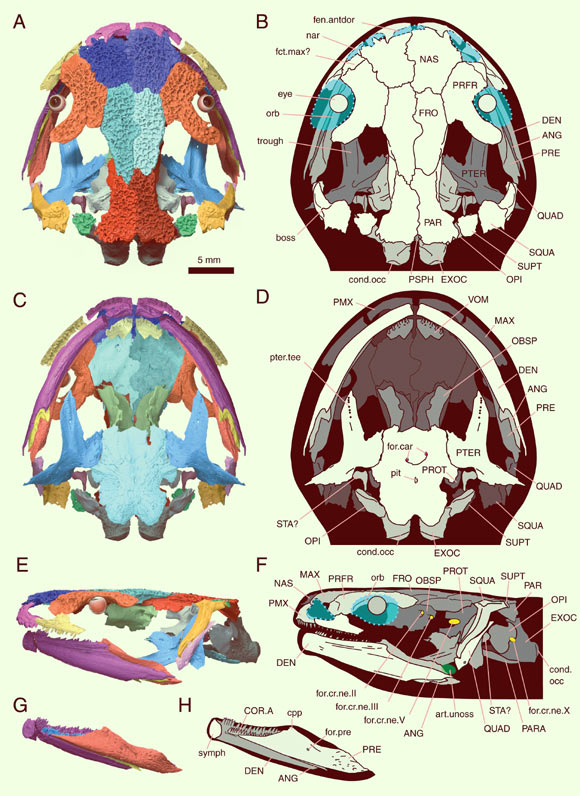Paleontologists have described a new species of the enigmatic stem-salamander genus Marmorerpeton from the well-preserved fossils found on the Isle of Skye, Scotland.

Reconstruction of cranium and lower jaw of Marmorerpeton wakei. Image credit: Jones et al., doi: 10.1073/pnas.2114100119.
Salamanders are an important group of amphibians that includes over 760 living species.
These creatures are important components of terrestrial and freshwater ecosystems. They are ecologically and developmentally diverse, including burrowers, climbers, cave dwellers and neotenic swimmers, and exhibit great variation in life history and degrees of parental care.
Salamanders are also important as model organisms for investigating development, regeneration, terrestrial locomotion, skull shape, body shape, feeding, genome size, and toxicity. However, their evolutionary origins are poorly understood, and their early fossil record is poor.
Many previous studies of fossil salamanders have relied heavily on fossils from the Late Jurassic period, found in Kazakhstan, belonging to the genus Karaurus.
As new fossils are found that predate this — such as Marmorerpeton — they provide a more complete understanding of how early salamanders evolved.
Marmorerpeton is an extinct genus of stem-salamanders that lived in Europe during the Middle Jurassic period.
First described over 30 years ago, it includes two other species, Marmorerpeton kermacki and Marmorerpeton freemani. But they are known from a few isolated fossil vertebrae and partial jaw bones, making Marmorerpeton somewhat enigmatic.
“The newly-identified species, Marmorerpeton wakei, is definitely a salamander but unlike anything alive today,” said Dr. Marc Jones, a paleontologist at University College London.
“It highlights the importance of the fossil record for preserving combinations of anatomical features that do not exist in any living animal.”
Marmorerpeton wakei lived in what is now Scotland some 166 million years ago (Middle Jurassic period).
It had a wide, shallow frog-like head but powerful jaws and distinctive, prominent projections behind the eyes.
The skull roof bones show that it was ornamented like that of a crocodile, setting it apart from modern salamanders.
Its limb bones and deep tail suggest this species was aquatic, perhaps using its wide jaws to catch prey by suction feeding.
“The big bony projections behind the eye were a bit unexpected but smaller projections do exist in fossil salamanders from slightly younger rocks. Their purpose remains unknown,” Dr. Jones said.
Three partial skeletons of Marmorerpeton wakei — the oldest salamander fossils found in Europe — were discovered in the Kilmaluag Formation on the Isle of Skye.
“The origin and early history of modern amphibian groups remains mysterious and new fossils like this one are key to developing a better understanding of amphibian evolution,” said University College London’s Professor Susan Evans, who first described Marmorerpeton in 1988.
“In theory, the Skye salamander should give us a clue as to what the ancestors of modern salamanders looked like. However, it could be that they are a highly specialized off-shoot.”
“The fossil site on Skye is proving to be a treasure trove for our understanding of the Middle Jurassic fauna and ecosystems, and is helping to fill gaps in the fossil record of many animal lineages including mammals, reptiles and amphibians,” said Professor Roger Benson, a paleontologist at the University of Oxford.
The findings appear in the Proceedings of the National Academy of Sciences.
_____
Marc E.H. Jones et al. 2022. Middle Jurassic fossils document an early stage in salamander evolution. PNAS 119 (30): e2114100119; doi: 10.1073/pnas.2114100119







